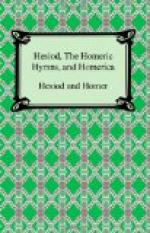The “Cyprian Lays”, ascribed to Stasinus of Cyprus (14) (but also to Hegesinus of Salamis) was designed to do for the events preceding the action of the “Iliad” what Arctinus had done for the later phases of the Trojan War. The “Cypria” begins with the first causes of the war, the purpose of Zeus to relieve the overburdened earth, the apple of discord, the rape of Helen. Then follow the incidents connected with the gathering of the Achaeans and their ultimate landing in Troy; and the story of the war is detailed up to the quarrel between Achilles and Agamemnon with which the “Iliad” begins.
These four poems rounded off the story of the “Iliad”, and it only remained to connect this enlarged version with the “Odyssey”. This was done by means of the “Returns”, a poem in five books ascribed to Agias or Hegias of Troezen, which begins where the “Sack of Troy” ends. It told of the dispute between Agamemnon and Menelaus, the departure from Troy of Menelaus, the fortunes of the lesser heroes, the return and tragic death of Agamemnon, and the vengeance of Orestes on Aegisthus. The story ends with the return home of Menelaus, which brings the general narrative up to the beginning of the “Odyssey”.
But the “Odyssey” itself left much untold: what, for example, happened in Ithaca after the slaying of the suitors, and what was the ultimate fate of Odysseus? The answer to these questions was supplied by the “Telegony”, a poem in two books by Eugammon of Cyrene (fl. 568 B.C.). It told of the adventures of Odysseus in Thesprotis after the killing of the Suitors, of his return to Ithaca, and his death at the hands of Telegonus, his son by Circe. The epic ended by disposing of the surviving personages in a double marriage, Telemachus wedding Circe, and Telegonus Penelope.
The end of the Cycle marks also the end of the Heroic Age.




